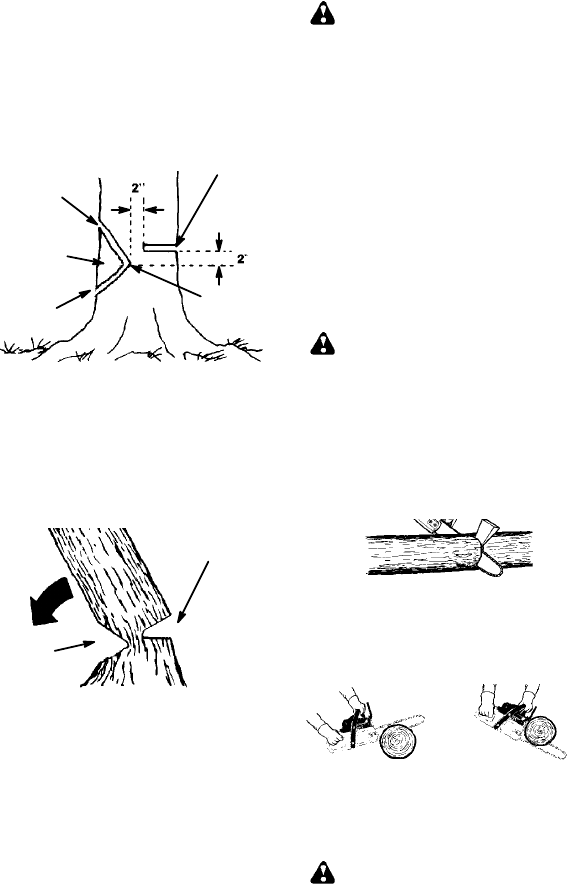
12
NOTE: If the t ree has large buttress r oots,
removethembeforemakingthe notch. If us-
ing saw to r emo ve but tress roots, keep saw
chain fromcontacting groundtopreventdull-
ing of the chain.
NOTCH CUT AND FELLING THE
TREE
S Make notch cut by cutting the top of the
notch first. Cut through
1/3 of the diameter
ofthetree. Nextcompletethe notchby cut-
ting the bottom of the notch. See illustra-
tion. Once the notch is cut remove the
notch of wood from the tree.
Notch
First cut
Second cut
Final (felling) cut here, 2 inches
(5 cm) above center of notch.
Hinge
S After removing the wood from the notch,
make the felling cut on the opposite side of
the n otch.This is doneby making a cut about
two inches (5 cm) higher than the center of
the notch. This will leave enough uncut wood
between t he felling cut and t he notch to f orm
a hinge. This hinge will help prevent the tree
from falling in the wrong direction.
Opening
of felling
cut
Closing of
notch
Hinge holds tree on stump and helps
control fall
NOTE: Before felling cut is complete, use
wedges to open the cut if necessary to
controlthedirectionoffall. Toavoidkickback
and chain damage, use wood or plastic
wedges, but never steel or iron wedges.
S Be alert to signs that the tree is ready to
fall: cracking s ounds, widening of the fell-
ing cut, or movement in the upper
branches.
S As tr eestarts to fall, stop saw, put it down,
and get away quickly on your planned re-
treat path.
S DO NOT cut down a partially fallen tree
with your saw. Be extremely cautious with
partially fallen trees that may be poorly
supported. When a tree doesn ’t fall com-
pletely,set thesaw asideandpull downthe
tree with a cable winch, block and tackle,
or tractor .
CUTTING A FALLEN TREE
(BUCKING)
Bucking is the term u sed for cutting a fallen
tree to the desired log size.
WARNING: Do not stand on the log
being cut. Any portion can roll causing los s
of footing and control. D o not stand downhill
of the log being cut.
IMPORTANT POINTS
S Cut only one log at a time.
S Cut shattered wood very carefully; sharp
pieces of wood could be flung toward opera-
tor .
S Use a sawhorse to cut small logs. Never
allow another person to hold the log while
cutting andneverhold thelog with your leg
or foot.
S Do not cut in an area where logs, limbs,
and roots are tangled such as in a blown
down area. Drag the logs intoa cleararea
before cutting by pulling out exposed and
cleared logs first.
TYPES OF CUTTING USED FOR
BUCKING
WARNING: Ifsaw becomespinched
or hungin a log, don’t try to f orce it out . You
can lose control of the saw resulting in injury
and/or damage to the saw. Stop the saw,
drive a wedge of plastic or wood into the cut
until thesaw can beremovedeasily. Restart
the saw and carefully reenter the cut. To
avoid kickback and chain damage, do not
use ametal wedge. Do notattempt to restart
your saw when itis pinched or hung in a log.
Use a wedge to r emove pinched saw
Turn s aw O FF and use a plastic o r
wooden wedge to force cut open.
Overcutting begins on the top side of the log
with the bottom of the saw against the log.
When overcutting use light downward pres-
sure.
Overcutting
Undercutting
Undercuttinginvolves cutting on theunder-
side ofthe logwithtop ofsawagainstthe log.
When undercutting use light upward pres-
sure. Hold saw firmly and maintain control.
The saw w ill tend to push back t oward you.
WARNING: Never turn saw upside
down to undercut. The saw cannot be con-
trolled in this position.
Always make your first cut on the compres-
sion side ofthe log. Thecompressionsideof
the log is where the pressure of the log’s
weight is concentrated.


















